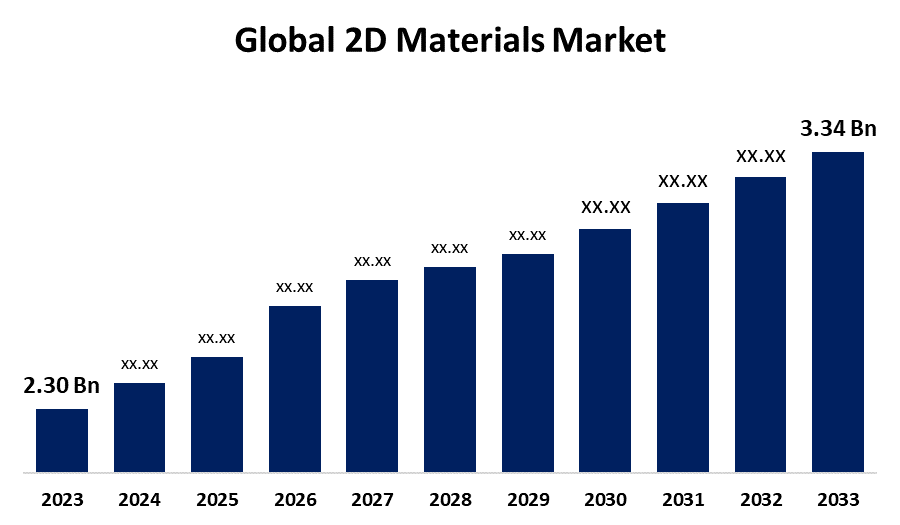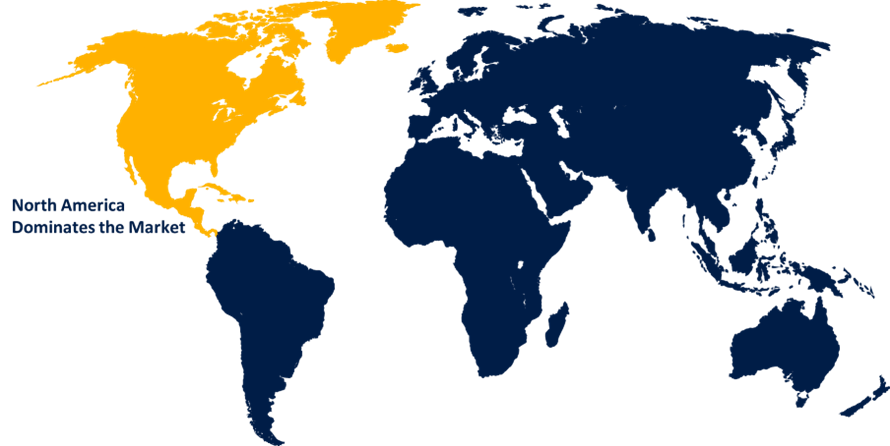Global 2D Materials Market Size, Share, and COVID-19 Impact Analysis, By Materials Type (Graphene, Hexagonal Boron Nitride, Black Phosphorus, Germanene, Silicene, and Others), By End-User (Electronics, Energy Storage Devices, Composite & Coating, Biomedical Applications, and Others), and By Region (North America, Europe, Asia-Pacific, Latin America, Middle East, and Africa), Analysis and Forecast 2023 - 2033.
Industry: Advanced MaterialsGlobal 2D Materials Market Insights Forecasts to 2033
- The Global 2D Materials Market Size was Valued at USD 2.30 Billion in 2023
- The Market Size is Growing at a CAGR of 3.80% from 2023 to 2033
- The Worldwide 2D Materials Market Size is Expected to Reach USD 3.34 Billion by 2033
- Aisa Pacific is Expected to Grow the fastest during the forecast period.

Get more details on this report -
The Global 2D Materials Market Size is Anticipated to Exceed USD 3.34 Billion by 2033, Growing at a CAGR of 3.80% from 2023 to 2033.
Market Overview
A 2D material is exceedingly thin and usually consists of a single or a few layers of atoms or molecules organized in a two-dimensional structure. These materials have distinct features due to their atomic-scale thickness, such as strong electrical conductivity, extraordinary mechanical strength, and optical transparency. It is projected that end-use sectors including composites and coatings, energy storage devices, electronics, semiconductors, medicines, automotive, and others increase their need for 2D materials. Additionally, the global market is driven primarily by the growing use of 2D materials in the healthcare sector and the growing use of non-graphene 2D materials like Mxene, TMDCs, hexagonal boron nitride, and others. The 2D materials market is being driven by increased usage of renewable energy, increased use of 2D materials in hydrogen fuel cells in electric vehicles, cost-cutting initiatives, ecologically friendly norms, and pollution-free policies by governments. Investing in research and development operations broadens the reach of the 2D materials market. Many major key players are investing in R&D to develop new technologies for 2D material products, driving growth. The increasing demand for 2D materials in industries such as healthcare, aerospace, and electronics, as well as the growing demand for transparent displays, solar modules, and devices, is driving considerable production investments. Growth is supported by improvements in the graphene domain and the invention of generating 2D materials.
Report Coverage
This research report categorizes the market for 2D materials market based on various segments and regions forecasts revenue growth and analyzes trends in each submarket. The report analyses the key growth drivers, opportunities, and challenges influencing the 2D materials market. Recent market developments and competitive strategies such as expansion, product launch, and development, partnership, merger, and acquisition have been included to draw the competitive landscape in the market. The report strategically identifies and profiles the key market players and analyses their core competencies in each sub-segment of the 2D materials market.
Global 2D Materials Market Report Coverage
| Report Coverage | Details |
|---|---|
| Base Year: | 2023 |
| Market Size in 2023: | USD 2.30 Billion |
| Forecast Period: | 2023-2033 |
| Forecast Period CAGR 2023-2033 : | 3.80% |
| 2033 Value Projection: | USD 3.34 Billion |
| Historical Data for: | 2019-2022 |
| No. of Pages: | 216 |
| Tables, Charts & Figures: | 110 |
| Segments covered: | By Materials Type, By End-User, By Region |
| Companies covered:: | 2D-TECH, Graphenea, Haydale Graphene Industries, Versarien, ACS materials, Nitronix, Thomas-swan, Garmor, Shanghai Viff International Trade Co., Ltd, planarTECH LLC, 2D fab, and Others |
| Pitfalls & Challenges: | Covid-19 Empact, Challenges, Growth, Analysis. |
Get more details on this report -
Driving Factors
The 2D market growth is driven by governments and large corporations are funding R&D projects to expand the range of uses for 2D materials and improve their affordability and scalability. The production of 2D materials is challenging due to technological advancements in manufacturing, as it involves significant costs and limitations. The market for 2D materials is expanding due to the need for these materials in a variety of industries, including electronics, energy storage, and healthcare. The significant industry expenditures made in the Asia Pacific region are fueling the boom in 2D materials. Governments are likely to place more emphasis on pollution-free rules and eco-friendly requirements, which would increase demand for 2D materials across a wide range of businesses. The 2D materials Market is expanding due to the rising need for 2D materials in industries including energy storage, biomedical technology, electronics, composites & coatings, and wastewater treatment.
Restraining Factors
The growth of the 2D materials market is constrained by the high cost of production, the small size of the manufacturing process, standardization, and regulations. Materials with competitive advantages in the technology industry, such as carbon nanotubes and quantum dots, restrict the expansion of the 2D materials market. Technology and environmental concerns provide unique impacts for a variety of applications, challenging the 2D materials market. Further complicating market entry and expansion include variations in material qualities, rival technologies, and patent and intellectual property rights difficulties.
Market Segmentation
The 2D materials market share is classified into material type and end-user.
- The graphene segment is estimated to hold the highest market revenue share through the projected period.
Based on the material type, the 2D materials market is classified into graphene, hexagonal boron nitride, black phosphorus, germanene, silicene, and others. Among these, the graphene segment is estimated to hold the highest market revenue share through the projected period. The graphene segment is owing to its exceptional electrical conductivity, mechanical durability, and transparency, graphene is the most researched and commercially available 2D substance. Transistors, transparent electrodes, and composite materials are some of its applications. The optical and electrical characteristics of transition metal dichalcogenides (TMDCs), such as tungsten disulfide (WS2) and molybdenum disulfide (MoS2), make them perfect for photodetectors, LEDs, and transistors. Producers are eager to produce supplies, integrate graphene into existing procedures, and explore new uses of graphene in industry applications, like electronics, thermal control, and structural applications, as the material's processing and production advance.
- The composite & coating segment is anticipated to hold the largest market share through the forecast period.
Based on the end-user, the 2D materials market is divided into electronics, energy storage devices, composite & coating, biomedical applications, and others. Among these, the composite & coating segment is anticipated to hold the largest market share through the forecast period. In the 2D materials market, major market shares are held by PPG Industries, Axalta Coating Systems, NanoXplore, 2D Materials Pte Ltd, and other diverse industries. The predicted market leadership of the composite & coating segment in 2D materials points to substantial potential in sectors including construction, automotive, and aerospace. These materials are probably highly sought-after for a variety of applications since they likely provide improved qualities like strength, lightweight features, and corrosion resistance.
Regional Segment Analysis of the 2D Materials Market
- North America (U.S., Canada, Mexico)
- Europe (Germany, France, U.K., Italy, Spain, Rest of Europe)
- Asia-Pacific (China, Japan, India, Rest of APAC)
- South America (Brazil and the Rest of South America)
- The Middle East and Africa (UAE, South Africa, Rest of MEA)
North America is anticipated to hold the largest share of the 2D materials market over the predicted timeframe.

Get more details on this report -
North America is anticipated to hold the largest share of the 2D materials market over the predicted timeframe. North America is anticipated to control the global market for 2D materials because of its strong R&D infrastructure, numerous industrial applications ranging from electronics to healthcare, significant investment and funding support, and a supportive regulatory environment that fosters innovation. The demand for automation is anticipated to rise due to factors like the number of prominent businesses operating in the nation and growing car manufacturing volumes. The US market for 2D materials is expected to be further supported over the forecast period by encouraging government policies and rising investments from both public and private entities.Top of Form
Asia Pacific is expected to grow at the fastest CAGR growth of the 2D materials market during the forecast period. The region is driven by major investments made by emerging economies like China, Japan, India, and others in sectors like energy storage, composites, textiles, transportation, and others. The Asia Pacific market is predicted to grow due to factors like the growing manufacturing sector and the region's developing semiconductor industry. Throughout the forecast period, the Asia Pacific market for 2D materials is expected to increase due to a growing need for automation among various firms.
Competitive Analysis:
The report offers the appropriate analysis of the key organizations/companies involved within the 2D materials market along with a comparative evaluation primarily based on their product offering, business overviews, geographic presence, enterprise strategies, segment market share, and SWOT analysis. The report also provides an elaborative analysis focusing on the current news and developments of the companies, which includes product development, innovations, joint ventures, partnerships, mergers & acquisitions, strategic alliances, and others. This allows for the evaluation of the overall competition within the market.
List of Key Companies
- 2D-TECH
- Graphenea
- Haydale Graphene Industries
- Versarien
- ACS materials
- Nitronix
- Thomas-swan
- Garmor
- Shanghai Viff International Trade Co., Ltd
- planarTECH LLC
- 2D fab
- Others
Key Target Audience
- Market Players
- Investors
- End-users
- Government Authorities
- Consulting And Research Firm
- Venture capitalists
- Value-Added Resellers (VARs)
Recent Developments
- In March 2024, The Graphene Flagship and Advanced Materials 2030 Initiative's suggested Innovative Materials for EU partnership was accepted when the European Commission (EC) approved the second strategic plan for Horizon Europe.
Market Segment
This study forecasts revenue at global, regional, and country levels from 2023 to 2033. Spherical Insights has segmented the 2D materials market based on the below-mentioned segments:
Global 2D Materials Market, By Materials Type
- Graphene
- Hexagonal Boron Nitride
- Black Phosphorus
- Germanene
- Silicene
- Others
Global 2D Materials Market, By End-User
- Electronics
- Energy Storage Devices
- Composite & Coating
- Biomedical Applications
- Others
Global 2D Materials Market, By Regional Analysis
- North America
- US
- Canada
- Mexico
- Europe
- Germany
- UK
- France
- Italy
- Spain
- Russia
- Rest of Europe
- Asia Pacific
- China
- Japan
- India
- South Korea
- Australia
- Rest of Asia Pacific
- South America
- Brazil
- Argentina
- Rest of South America
- Middle East & Africa
- UAE
- Saudi Arabia
- Qatar
- South Africa
- Rest of the Middle East & Africa
Frequently Asked Questions (FAQ)
-
1. What is the CAGR of the 2D materials market over the forecast period?The 2D materials market is projected to expand at a CAGR of 3.80% during the forecast period.
-
2. What is the market size of the 2D materials market?The Global 2D Materials Market Size is Expected to Grow from USD 2.30 Billion in 2023 to USD 3.34 Billion by 2033, at a CAGR of 3.80% during the forecast period 2023-2033.
-
3. Which region holds the largest share of the 2D materials market?North America is anticipated to hold the largest share of the 2D materials market over the predicted timeframe.
-
1. What is the CAGR of the 2D materials market over the forecast period?The 2D materials market is projected to expand at a CAGR of 3.80% during the forecast period.
-
2. What is the market size of the 2D materials market?The Global 2D Materials Market Size is Expected to Grow from USD 2.30 Billion in 2023 to USD 3.34 Billion by 2033, at a CAGR of 3.80% during the forecast period 2023-2033.
-
3. Which region holds the largest share of the 2D materials market?North America is anticipated to hold the largest share of the 2D materials market over the predicted timeframe.
Need help to buy this report?